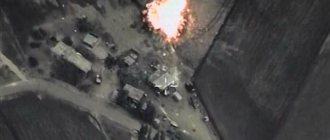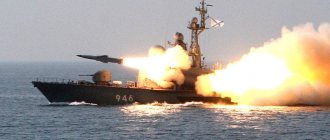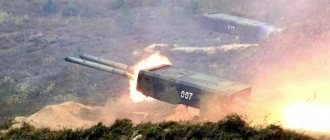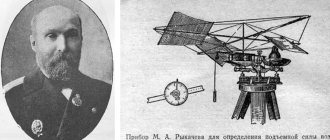Aviation tactical missile Kh-29T
The Kh-29T missile has a canard aerodynamic design (see projections, layout diagram). The X-29T body consists of five compartments - seeker, control compartment, warhead, engine and tail compartment, which can be stored separately in a cap and assembled during preparation using flange joints.
To improve controllability, destabilizers are installed in front of the rudders, called “load-bearing ridges” on the X-29. Roll control (stabilization) is carried out by ailerons on the wing. The power supply of the systems and the seeker is provided by an ampoule battery and an electromechanical AC converter with a power supply resource of 40 s.
To destroy strong and protected targets, the missile is equipped with a powerful penetrating warhead 9B63MN weighing 317 kg, and equipped with a KVU-63 contact fuse, which provides a detonation with a specified deceleration after breaking through the barrier, destroying the contents of the shelter. The warhead is equipped with a special anti-ricochet device on the front part, which increases the effectiveness of the strike at small “sliding” angles of contact with the target, which are common when launching from low altitudes and distances. The operating mode of the fuse (“instantly” or “delayed”) is set by the pilot, and contact sensors are placed in front of the warhead in the body in the area of the control surfaces and run along the leading edges of the wing. The durable casing accounts for the bulk of the warhead's mass; the weight of the explosive is 116 kg.
The Kh-29T missile has a passive television homing system (see.
). The measurement of the target bearing angles and the angular velocity of the line of sight is carried out using the Tubus-2 television seeker, the field of view of which in the target search mode is 12° x16° and in the auto tracking mode - 2.1° x2.9°. The maximum angular speed of the line of sight is 10° /s.
TGSN "Tubus-2" consists of an optical-electronic part with a target coordinator mounted on a gimbal, and an electronic information processing unit that ensures the selection and storage of contrasting objects. The search for a target can be carried out using the aircraft's on-board equipment or visually by the pilot.
Having detected a target and “driving” it onto the flight sighting indicator, the pilot performs binding and target designation of the TGSN, after which the target image appears on the screen of the television indicator in the cockpit. The intended target of an attack can be “snatched” from the general background by a television camera, and its image is enlarged for identification. After identifying the target, a transition is made from the wide field of view of the TGSN to a narrow one, and to maintain the lock, the pilot can only hold the aiming frame on the target with the joystick, waiting for the approach to the permitted launch range.
The vertical control system operates in two modes, autonomous and homing. Autonomous control is carried out during the initial phase of the rocket's flight, and homing is carried out during the last phase. After separation from the carrier aircraft, autonomous control ensures that the rocket flies at a constant pitch angle. When the current bearing angle is equal to the specified one, the control system performs a programmatic turn of the missile towards the target until the current value of the angular velocity of the line of sight equals zero. After this, missile control switches to passive television homing using the proportional approach method. Television homing is passive in nature and is carried out along the light-contrast edge of the target. The conspicuity of the target can be emphasized not only by its contrasting color, but also by the angle of incidence of the sun's rays or shadows revealing a camouflaged object. The rocket makes a “slide” in front of the target.
The X-29T can be launched from low altitudes. The range of its use is determined mainly by the ability to detect a target and is highly dependent on flight altitude, atmospheric conditions, contrast, size and configuration of the target. The circular probable deviation when launching from 4-5 km, which is optimal for target detection conditions, is 2.2 m.
When striking airfield runways, the missile leaves craters with a diameter of 12 to 15 m and a depth of up to 6 m.
A container is used to transport and store the X-29T missile.
PUYERU u-29r OPEDMYUGMYUVEMU DK ONPUFEHMKH BHGSYUKEMN BKHDHLSHU MUGELMSHU X MYUDBNDMSHU JACKEYS RHOYU: FEKEGNAERNMMSHE SYPSHRKH, YARYUZHNMYUPMSHE FEKEGMNDNPNFMSHE X BNNYAYAYEEMSHE LNYARSH, OPNLSHKEMMSHE YANNPSFEMKH, YAYKYUDSH, AERNMHPNBYUMMSHE boo, YNPYUAKH H DEYUMMRMN-BSHYUDNVMSHE YAPEDYARBU. pYUGPYUANRYU PYYERSH u-29 MYVYUKYUYAE B ya "lNKMHЪ" OND PSYNBNDYARBNL TSKYUBMNTSN YNMYARPSYRNPYU l.p.aKHYAMNBURYU, B DUKEMEYEL PUANRSH ASHKKH OEPEDYUMSH B lya "bSHLOEK".u-29r (ХГД.63) KHLEER REKEBHGHNMMSC YAHYARELS MYUBEDEMKH - OYUYAYAHBMSCH X ONKMNNYARECH YUBRNMNLMSCH, B NRKHVHE NR KYUGEPMNI X PUDHNYNLYUMDMNI. rtsyam YANYARNHR XG NORKHYN-SCHKEYRPNMMNI VYUYARKH I YNNPDHMYURNPNL ZHEKKH, GYUPEOKEMMSHL MU YUPDYUMMMNL ONDBEYAE, KH SHCHKEIRPNMMNTSN AKNYU NAPUANRYH KHMTNPLYUZHHH, NAEYAOEVKHBUCHYKHU B SHDEKEMHE KH GUONLHMYUMHE YNMRPUYARMSHU NAZEIRNB. ONLHLN SYARYUMNBYKH rtsam "RSASYA-2", PYUGPYUANRYUMMNI mon "HLOSKEYA", YNMYARPSYZHKH NAYEHU PUYER KHDEMRKHVMYU, BYKCHVYU TSYUGNYAMYUAFEMKHE KH SHKEIRPNOKHRYUMKHE I PEYASPIANL MU 40 YAYE . PYUANRSH. ONHYAY ZHEKH LNFER BEYARKHYAE I ONLNYECH ANPRNBNI YOOYUPYURSPSH YAYULNKERYU HKKH BKHGSYUKEMN KERVKHYNL. NAMYUPSFKHB ZHEKE KH "GYUTSMYUB" EE MU OPKHZHEKEMN-OHKNRYUFMSHHI KHMDHYURNP, KERVKHY BSHONKMER OPHBGYS KH ZHEKESYUGYUMKHE rtsyam, ONYAKE VETSN KHGNAPUFEMKHE ZHEKH ONEBKYERYA KH MU SHYPYUME REKEBHGHNMMNTSN KHMDHYURNPYU B YUAHME. OPEDONKYUTSYUELSHI NAZEIR YURYUYKH LNFER ASHRE "BSHUBYUVEM" REKEYYULEPNI KH NAYETSN TNMYU, YU ETSN KHGNAPUFEMKHE SBEKHVEMN DK NONGMYUMKH. bSHDEKKHB ETSN, OPNKHGBNDHRYA OEPEUND I bHPNYNTsN ONK GPEMKH rtsyam MU SGYNE, YU DK YANUPYUMEMKH GUUBURYU KERVHYS NYARYUERYA RNKEIN SDEPFKHBURE YMCHOOEKEL OPHZHEKEMSCH PYULYS MU ZHEKH, NFKHDU YAAKKHFEMKH I ZHEKECH MU PYUGPEEMMSCH DUKEMNYARE OSYAYU. SAEDKHBHYAE B MYUDEFMNL GUUBYURE BSHDEKQYEIYYYU TNME LEYARMNYARKH ZHEKH, NM OPNKHGBNDHR OSYAY PUYERSH.
REKEBHGKHNMMNE YYULNMYUBEDEMKHE MNYAHR OYYAYAHBMSHYYUPYUREP X OPNHGBNDHRYA ON YABERNYNMRPYYARMNLS YPYUCH ZHEKH - RELMNLS HKH YABERKNLS MY NAYEL TNME (GULERMNYARE ZHEKH OPH SCHRNL LNFER ONDVEPYKHBUREYA ME RNKEIN ITS YNMRPUYARMSHL ZHBERNL, MN X STSKNL OYUDEMKH YANKMEVMSHU KSVEI XKH REMLKH, BSHDUCHYHLH GYULYUYAYKHPNBUMMSHI NAZEIR). REKEBKHGHNMMNE YAYULNMYUBEDEMHE ONKMNNYARECH YUBRNMNLMN, GYUYKHYEMN NR ONLEU KH ME YAYNBSHBUER KERVHJU B LYUMEBPE ONYAKE OSYAYU.
b PEFHLE ONHYAYU SCSC GPEMKH rtsyam “RSASYA-2″ YANYARYUBKYER 12×16″, B PEFHLE YUBRNYANOPNBNFDEMHЪ ZHEKKH - 2.1×2.8”. nMY PUANRUER B rb-YARYUMDUPR - 625 YARPNY I PYUGPEEMHEL 550 KHMKHI. jasp NAEYAOEVKHBUER YUBRNMNLMNE SOPYUBKEMKHE: VEPEG 0.8 YAYSMD ONYAKE OSYAYU PUYERYU MYVHMYUER MUANP BSHYANRSH - “TSNPYS” I ONYARNMMSHL STSKNL RYUMTSYUFYU, GYUREL OPNHYAUNDHR OPNTsP YULLMSHY PUGBNPNR MU ZHEKE X OKHYHPNBYUMHE. OSYAY u-29r LNFER NYASYYARBKЪREYA KH I LYUKSHU BSHYANR. DUKEMNYARE ITS OPHLEMEMKH NOPEDEKERYA, B NYAMNBMNL, BNGLNFMNYARECH NAMYUPSFEMKH ZHEKH KH GYUBHYAHR NR BSHYANRSH ONKERYU, YURLNYATEPMSHU SYAKNBKHI, YNMRPYYARMNYARKH, PUGLEP NB X YNMTHTSSPYUZHXX ZHEKH. LYUYAKHLYUKEMYU DUKEMNYARE OSYAYU u-29r YANYARYUBKYER 8-13 YL. oPH MUMEYAEMXX SDYUPYU OH YUSCHPNDPNLMSHL ONKNYYUL X-29 NYARYUBKER BNPNMYKH DHYULERPNL DN 12-15 L X TsKSAKHMNI DN 6 L.
rnvmnyare onoyudyumkh u-29r YASYYYARBEMMN BSHDEKER ITS YAPEDH OPNVHU YAPEDYARB ONPUFEEMKH - YPSTSNBNE BEPNЪRMNE NRYKNMEMHE "REKEBKHGHNMMNI" PUYERSH, ME GYUBHYAYYEI NR OND YABERYKH DPSTSNI "ONLNYH YAN YARNPNMSH", OPH OSYAYE I NORHLYUKEMSHU ON SYAKNBKHL NAMYUPSFEMKH ZHEKH 4-5 YL YANYARYUBKER 2.2 L (With KYUGEPMSHU SHRNR OYUPYULERP PYUBEM 3.5-4 L). BLEYARE I REL, PUYERU LNFER HYAONKEGNBUREYA RNKEIN B DMEBMNE BPEL, ON YNMRPYYARMSHL NAZEYRYUL H B UNPNNSCH ONTSNDS, OPH NRYASRYARBHH RSLYUMYU H DSHLYH.
oNLHLN DBSU AYUGNBSHU BYUPKHYUMRNB, lya "bSHLOEK" B PEIKYULMSHU HYARNVMHYUU YANNAYYUKN N PUGPYUANRYE PYYER u-29rsch I SBEKHVEMMNI DN 20-30 YL DUKEMNYARECH YARPEKEASH, u-29l k B YNLOKEYAE YAN YARYUMZHKHEI DUKEMETSN ONDYABERYU KH DUKEMNLERPHPNBYUMKH X LNDEKEY I YUBRNMNLMNI INCEPEMRMNI pktsam PYUGPYUANRYH "tyUGNRPNM- mhhp."
X-29
The X-29 family of missiles are short-range missiles and require visual contact with the target to fire. On the one hand, this guarantees correct target selection, on the other, the carrier aircraft is forced to enter the enemy’s air defense coverage area.
Application tactics
The tactics of using Kh-29 (A) missiles is from a dive;
(B) — from a high-altitude flight; (B) - from a low-altitude flight (1) - “slide”; (2) - diving on the target The algorithm for using all modifications of the missile is similar: the pilot of the carrier aircraft determines the position of the target, points the flight indicator at it and holds it until the missile homing head achieves a stable capture of the target. Next, the rocket is launched, immediately after which the carrier aircraft can leave the firing zone. In the case of using missiles with a laser homing system, the gunner (carrier aircraft, another aircraft or ground gunner) must illuminate the target with a laser until the missile hits. In the case of using missiles with a television or radar homing head, this is not required[9].
Depending on the air defense systems used by the enemy, the tactics for using missiles vary. If the enemy has long- and medium-range air defense systems, then the carrier aircraft approaches the target at low altitudes, skirting the terrain, where it is a difficult target for anti-aircraft missiles[23]. In this case, the rocket, driven by the autopilot, makes a “slide” - that is, using the speed given by the carrier and its own rocket engine, it gains altitude and takes a position above the target [24] [ unauthorized source?
]. If the enemy only has anti-aircraft artillery, short-range air defense systems and MANPADS, then a dive-launched missile is used. In this case, the aircraft approaches the target at a high altitude, where it is invulnerable to fire from the ground, and dives in the direction of the target. To reduce the dive speed, aircraft brake flaps are produced. As soon as the pilot confirms the stable capture of the target by the homing head, he immediately launches and exits the dive, rising to altitude again. Launching a rocket from high-altitude horizontal flight is possible, but is rarely used in practice[24].
The missile, once above the target, goes into homing mode and begins a steep dive. The tracking coordinator of the seeker holds the target, and the rocket autopilot, based on the angular velocity of the coordinator’s movement, issues corrective signals to the air rudders[9].
Combat use
Kh-29 missiles have been actively used in many recent armed conflicts, where they have proven their high effectiveness.
Afghan War (1979-1989)
Main article: Afghan War (1979–1989)
The first combat use of Kh-29 missiles by Soviet troops occurred in April 1987 in Afghanistan. From two Su-25 attack aircraft, piloted by A.V. Rutsky and Vysotsky, 4 missiles were fired at warehouses carved into the rocks[10].
The “Achilles heel” of this weapon was immediately revealed - dependence on weather conditions: due to dense smoke, two of the four missiles did not hit the target. The tactics of using precision weapons also had to be seriously reconsidered. Initially, it was assumed that the entire range of measures for the use of the X-29 would be carried out by one aircraft. But for the single-seat Su-25 attack aircraft, this turned out to be inapplicable - one pilot could not cope: he had to fly the plane under enemy fire and at the same time in a short time detect the target, aim the missile and illuminate the target before the ammunition hits. For a similar reason, the scheme in which a pair of aircraft was used, one of which illuminated the target, and the other struck, also turned out to be ineffective. The most successful was the practice of using missiles in good weather with the help of ground gunners who knew the terrain well and could irradiate the target with a laser for the necessary time, and the missile was launched from an attack aircraft from a distance of 4-5 km while diving at an angle of about 30°[2].
With the adoption of these measures, the missiles turned out to be so accurate that they made it possible to provide direct support to troops on the front line, in particular to destroy the bunkers of the dushmans. The commander of one of the airborne companies described the use of the X-29 in the following words: “a couple of planes flew over us, and then something light flew into the embrasure between the stones and smashed the bunker into rubble.”
[10]. With the advent of these missiles, bases, warehouses, workshops and firing points located in rock caves, which were extremely difficult targets for artillery and infantry, became vulnerable. Conventional aviation ammunition did little damage to such fortifications, because even a small miss meant a useless explosion in the rock. High-precision missiles hit directly the entrances of caves and even the embrasures of bunkers, making natural defense ineffective. The use of the Kh-29 missile against such targets was very effective - the heavy armor-piercing high-explosive warhead, breaking through the stone, exploded them from the inside [10].
After several headquarters and the Islamic Committee of Dushmans were destroyed by X-29 missiles, they realized the seriousness of the new weapon. A real hunt began for the ground gunners - specialized armored vehicles for aviation guidance (BOMAN) based on the BTR-70 armored personnel carriers even had to be hidden at air bases during breaks in hostilities.
In total, during the fighting in Afghanistan, according to the Sukhoi Design Bureau, 139 high-precision laser-guided missiles were fired[10].
Iran-Iraq War (1980–1988)
Main article: Iran–Iraq War
During the Iran-Iraq War, Iraqi troops used Kh-29 missiles from MiG-23BN and Mirage F-1[25] aircraft to destroy Iranian airfields, oil production facilities, bridges and port facilities[2] - both to create obstacles to the actions of the Iranian armed forces , and to undermine the economy of Iran, which received its main budget revenues from oil trade.
Particular attention was paid to the destruction of Iranian oil terminals on the coast of the Persian Gulf. In particular, the terminal on Kharg Island, located 225 km from the border, was attacked 77 times by Iraqi aircraft in the fall of 1985. Unguided missiles and free-falling bombs were ineffective against structures covered by powerful air defense, so Iraqi pilots switched to using high-precision laser-guided missiles - the French AS.30L and the Soviet Kh-29L. To overcome air defense systems, "Mirages" approached the island at low altitude at a distance of about 8-15 km, briefly rose to visual contact with the target, launched missiles and again went to low altitudes[23].
Target designation during such attacks was carried out from an aircraft at a high altitude and at a distance from the target, inaccessible to the air defense of the target of attack. For missile guidance, a French-made ATLIS laser target designation container was used, with which the range of use of the Kh-29L missiles increased to 15 km[7].
Later, for similar attacks, Iraqi troops adapted Exocet anti-ship missiles with a launch range of up to 30 km[23].
Chechen war (1994-1996) and (1999-2000)
Kh-29 missiles (together with the lighter Kh-25 and adjustable aerial bombs KAB-500 and KAB-1500) were used in military operations in Chechnya to destroy protected militant targets[26]. The climate of the northern Caucasus imposed serious restrictions on the use of high-precision weapons - poor visibility made it very difficult to capture targets with homing heads. For example, for the entire December 1994 in Chechnya there were only 2 days with clear weather, when it was possible to use all the capabilities of high-precision weapons[27].
Ethiopian-Eritrean conflict (1998–2000)
By 2000, Ethiopian aviation managed to largely seize air supremacy, but the situation was complicated by the supply of Kvadrat air defense systems from Ukraine, which posed a serious danger. The first complexes were delivered on May 19, 2000. The positions of the air defense system were determined by radio reconnaissance from the Su-27 patrolling the Ethiopian airspace.
The well-proven Su-25TK attack aircraft were chosen to hit targets. Each aircraft was equipped with two X-25MP high-precision missiles with radar homing heads and two X-29T missiles with television seekers. Flight range was ensured by a pair of external fuel tanks on each aircraft. Cover from enemy fighters was provided by three groups of Su-27 fighters, two of which were placed on the flanks, and another one at high altitude provided radar coverage. Radio-technical camouflage of the attack was carried out by ground-based active jamming stations.
Poorly trained Eritrean crews were not prepared for such a massive attack - Ethiopian attack aircraft unhindered approached to a distance of about 30 km and fired anti-radar missiles at detection and targeting radars. Each of the two radars was hit by two missiles, completely destroying them. The remaining 3 launchers “blind” were easily destroyed by attack aircraft with Kh-29T strikes with television seekers.
Radio-technical reconnaissance carried out after the raid confirmed the destruction of the enemy air defense system, and fighter-bombers took over, launching a massive airstrike against the Eritrean troops. However, the very next day, radio intelligence detected a second battery of “squares”, and aviation operations had to be suspended again.
To neutralize the threat, the same tactics were chosen as when destroying the first battery: the main blow was to be delivered by the Su-25 with high-precision missiles, cover was provided by the Su-27, and ground-based jammers were supposed to make it difficult for the air defense system to operate.
The attack aircraft, following the established pattern, approached missile launch range and fired at the complex’s radar with X-25MP anti-radar missiles. But, unlike the first case, the maintenance of the air defense system was carried out by well-trained Ukrainian specialists - having managed to quickly reject ground-based jamming stations, the “square” crew detected the attacking attack aircraft and fired 2 missiles at them. One of the anti-aircraft missiles hit the Su-25, after which anti-radar missiles destroyed the target designation station and the second missile self-destructed. The damaged attack aircraft was forced to withdraw from the battle, however, the pilot was able to land it safely at the base. The remaining Su-25 with two Kh-29s destroyed a pair of 2P25 launchers.
After radio intelligence confirmed the destruction of the SAM radar, the remaining launchers were destroyed by free-falling bombs from MiG-23BN fighter-bombers.[28].
Russian military operation in Syria (2015)
Main article: Russian military operation in Syria
The Kh-29L missile is used by Russian aviation in Syria.[29]
Incidents
At the end of the 1970s, at the Luninets training ground in Belarus, due to the failure of the ejection device on Major Ignatov’s Su-17 aircraft, the X-29 missile was not fired, but its engine worked. The plane was seriously damaged, but the pilot was able to land it safely at the base[30][ unauthorized source?
].
In one of the test flights over the Suurpaki test site on the MiG-27K aircraft of the 88th APIB [31] captain G. Krivoruchko, the engine of the X-29 rocket ruptured in flight. The warhead did not detonate. Fragments of the empennage and the rocket body damaged the skin of the plane, but the pilot was able to land the plane safely[32].
Homing missile
The missile was created to destroy targets on land and on water: reinforced concrete structures, railway bridges, warehouses, concrete shelters, warships. At first, the development of the model was carried out by the Molniya design bureau, whose engineers did most of the work. Later, the bureau stopped participating in the project due to the large number of orders for space programs. The completion of development and the further launch of serial production was carried out by the Vympel design bureau.
The X-29T has built-in self-guidance television technology called Tubus-2. Innovative for its time, the passive homing system is completely autonomous. After launching a missile, a combat aircraft can safely fly away from the active operations zone. The homing installation is equipped with a fixed video camera with a target tracking function and a software unit that designates and remembers the target, and also transmits commands to the tracking system and rocket rudders.










